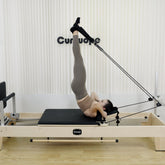A Beginner's Guide to Pilates Post-COVID,what does an absolute beginner need to know?
I've been dealing with Post-COVID for about a year now. I mostly struggle with dizziness, shortness of breath, fatigue, and high blood pressure. It sucks but my doctors can't find anything so I'm just holding out hope that my organs aren't that damaged. Before that, I used to work out semi regularly with weights and bodyweight, trying to lose the weight I gained during a episode of depression. I also started practicing yoga.
Even though my condition has improved, I'm not where I used to be. Weight training and higher intensity training is definitely still too much right now. I'm desperate to work out again and move my body, I miss it so much.
Yoga is fine but it doesn't really hit the sport so I figured I'd give Pilates a try. It's kind of like a combination of yoga and bodyweight training, doesn't get my heart rate up too high and I still feel kinda sore afterward. It also helps that it's more focused on the core and back and is knee-friendly, those are definitely my weaknesses, even before Post-COVID.
I can't commit to scheduled workouts just yet, so my focus is building strength slowly and being mindful of my body's limitations.
What does an absolute beginner need to know?
1.How can Pilates help after COVID?
After recovering from COVID-19, many individuals experience weakness, fatigue, and reduced lung capacity. Pilates can be a great way to regain strength, improve breathing, and boost overall well-being. The gentle and controlled movements in Pilates can help rebuild stamina and enhance lung function, making it an ideal exercise for post-COVID recovery.

2.How Does Pilates Benefit Post-COVID Recovery?
1. Strengthens the respiratory muscles: Pilates exercises focus on deep breathing and engaging the diaphragm, which can help improve lung function and increase oxygen intake.
2. Builds core strength: COVID-19 can weaken the core muscles, leading to poor posture and stability. Pilates targets the deep abdominal muscles, back muscles, and pelvic floor, helping to restore core strength and stability.
3. Enhances flexibility: Prolonged bed rest during COVID-19 recovery can cause muscle stiffness and reduced flexibility. Pilates incorporates stretching exercises that can improve flexibility and range of motion.
4. Promotes mental well-being: Pilates emphasizes mind-body connection and encourages mindfulness. It can help reduce stress, anxiety, and depression, which are common post-COVID symptoms.
3.Getting started with Pilates
Before starting any exercise program, it is important to consult with a healthcare professional, especially if you have recently recovered from COVID-19. Once you have the green light, here are a few steps to help you get started with Pilates:
1. Find a qualified instructor
Look for a certified Pilates instructor who has experience working with beginners and individuals recovering from illness. They will be able to guide you through the exercises safely and effectively.
2. Start with beginner-friendly exercises
Begin with basic Pilates exercises that focus on core strength and flexibility. These exercises are gentle on the body and can be modified to suit your current fitness level.
3. Listen to your body
Pay attention to how your body feels during the exercises. If something feels uncomfortable or painful, modify the movement or take a break. It's important to progress at your own pace and not push yourself too hard.
4. Be consistent
Consistency is key when it comes to Pilates. Aim to practice regularly, even if it's just a few minutes each day. Over time, you will start to notice improvements in your strength, flexibility, and overall well-being.
5. Enjoy the process
Pilates is not just about the physical benefits; it's also about connecting with your body and enjoying the process. Embrace the mind-body connection that Pilates offers and approach each session with a positive and open mindset.
4.The equipment you'll need
Pilates can be done with or without equipment. However, using certain props can enhance your practice. Some common Pilates equipment includes a Pilates mat, resistance bands, Pilates balls, and a Pilates reformer. Your instructor can recommend the appropriate equipment based on your fitness level and goals.
Conclusion
Pilates can be a valuable tool for individuals recovering from COVID-19. It provides a gentle yet effective way to rebuild strength, improve flexibility, and enhance overall well-being. By following the steps outlined in this beginner's guide, you can embark on a Pilates journey that will support your post-COVID recovery and help you achieve a stronger and healthier body.





